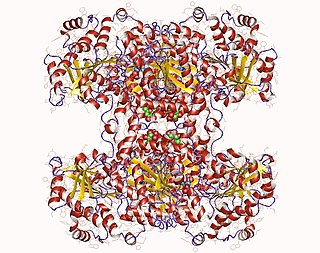
Galactose, sometimes abbreviated Gal, is a monosaccharide sugar that is about as sweet as glucose, and about 65% as sweet as sucrose. It is an aldohexose and a C-4 epimer of glucose. A galactose molecule linked with a glucose molecule forms a lactose molecule.

Glycogen synthase is a key enzyme in glycogenesis, the conversion of glucose into glycogen. It is a glycosyltransferase that catalyses the reaction of UDP-glucose and n to yield UDP and n+1.
Rhamnose is a naturally occurring deoxy sugar. It can be classified as either a methyl-pentose or a 6-deoxy-hexose. Rhamnose predominantly occurs in nature in its L-form as L-rhamnose (6-deoxy-L-mannose). This is unusual, since most of the naturally occurring sugars are in D-form. Exceptions are the methyl pentoses L-fucose and L-rhamnose and the pentose L-arabinose. However, examples of naturally-occurring D-rhamnose include some species of bacteria, such as Pseudomonas aeruginosa and Helicobacter pylori.

Uridine 5'-diphospho-glucuronosyltransferase is a microsomal glycosyltransferase that catalyzes the transfer of the glucuronic acid component of UDP-glucuronic acid to a small hydrophobic molecule. This is a glucuronidation reaction.

Hesperidin is a flavanone glycoside found in citrus fruits. Its aglycone is hesperetin. Its name is derived from the word "hesperidium", for fruit produced by citrus trees.

UTP—glucose-1-phosphate uridylyltransferase also known as glucose-1-phosphate uridylyltransferase is an enzyme involved in carbohydrate metabolism. It synthesizes UDP-glucose from glucose-1-phosphate and UTP; i.e.,
N-acetylglucosamine-1-phosphate transferase is a transferase enzyme.
In enzymology, a L-rhamnose isomerase is an enzyme that catalyzes the chemical reaction

The enzyme UDP-glucose 4-epimerase, also known as UDP-galactose 4-epimerase or GALE, is a homodimeric epimerase found in bacterial, fungal, plant, and mammalian cells. This enzyme performs the final step in the Leloir pathway of galactose metabolism, catalyzing the reversible conversion of UDP-galactose to UDP-glucose. GALE tightly binds nicotinamide adenine dinucleotide (NAD+), a co-factor required for catalytic activity.
The enzyme UDP-glucose 4,6-dehydratase (EC 4.2.1.76) catalyzes the chemical reaction
The enzyme quercitrinase (EC 3.2.1.66) catalyzes the following chemical reaction:
In enzymology, a flavanone 7-O-glucoside 2"-O-beta-L-rhamnosyltransferase is an enzyme that catalyzes the chemical reaction
In enzymology, a flavonol-3-O-glucoside L-rhamnosyltransferase is an enzyme that catalyzes the chemical reaction
In enzymology, an indolylacetylinositol arabinosyltransferase is an enzyme that catalyzes the chemical reaction

UDP-glucuronosyltransferase 2B17 is an enzyme that in humans is encoded by the UGT2B17 gene.

Rhamnolipids are a class of glycolipid produced by Pseudomonas aeruginosa, amongst other organisms, frequently cited as bacterial surfactants. They have a glycosyl head group, in this case a rhamnose moiety, and a 3-(hydroxyalkanoyloxy)alkanoic acid (HAA) fatty acid tail, such as 3-hydroxydecanoic acid.
Soyasapogenol B glucuronide galactosyltransferase is an enzyme with systematic name UDP-alpha-D-galactose:soyasapogenol B 3-O-glucuronide beta-D-galactosyltransferase. This enzyme catalyses the following chemical reaction
N-acetylglucosaminyl-diphospho-decaprenol L-rhamnosyltransferase is an enzyme with systematic name dTDP-6-deoxy-beta-L-mannose:N-acetyl-alpha-D-glucosaminyl-diphospho-trans,octacis-decaprenol 3-alpha-L-rhamnosyltransferase. This enzyme catalyses the following chemical reaction

Luteolin-7-O-glucuronide is a chemical compound that is classified as a flavone.









